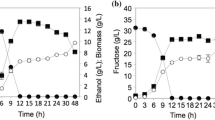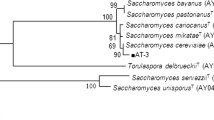Abstract
Oxidizing and assimilating ability of the yeastCandida utilis 49 was tested with 21 different low-boiling organic compounds which come as components of raw synthetic ethanol. The highest yields of yeast dry weight were obtained with ethanol (72.0%), propanol (48.2%), ethyl acetate (43.4%) and acetic acid (34.2%). To a minor extent, the yeast was capable of utilizing also 2-propanol, butanol and 2-butanol; it oxidized most of the compounds tested.
Similar content being viewed by others
References
Amano Y., Goto S., Kagami M.: A strongly ethanol assimilating new yeastCandida brassicae nov. sp,J. Ferment. Technol. 53, 311 (1975a).
Amano Y., Yoshida O., Kagami M.: Culture conditions of ethanol assimilating yeastCandida brassicae sp. nov. E-17.J. Ferment. Technol. 53, 204 (1975b).
Blagodatskaya V. M., Erofeeva Z. S., Eroshin V. K.: Methanol-utilizing yeasts. (In Russian)Mikrobiologiya 64, 362 (1975).
Van Dijken J. P., Harder W.: Optimal conditions for the enrichment and isolation of methanol assimilating yeasts.J. Gen. Microbiol. 84, 409 (1974).
Dijkhuizen L., Harder W.: Substrate inhibition inPseudomonaa oxaloticus OX 1: a kinetic study of growth inhibition by oxalate and formate using extended cultures.Anton. Leeuwenhoek J. Microbiol. Serol. 41, 135 (1975).
McGucken P. V., Woodside W.: Studies on the mode of action of glutaraldehyde onEacherichia coli.J. Appl. Bacteriol. 36, 419 (1973).
Guiraud J. P., Bizeau C., Arnaud A., Saguet H., Galzy P.: Action des composes a 2 carbones sur le metabolisme endogene de la levure.Mycopathol. Mycol. Appl. 53, 157 (1974).
Harada T., Hirabayashi T.: Utilization of alcohols byHansenula miso.Agr. Biol. Chem. 32, 1175 (1968).
Hirrabayashi T., Harada T.: A new keto acid, 5-aeetoxy-4-ketohexanoic acid, formed from ethanol by yeast.Agr. Biol. Chem. 33, 1074 (1969).
Hori M., Kunimuto T., Suzuki T.: Rapidly reversible dissociation of polysomes inEseherichia coli by n-butanol.J. Biochem. 66, 705 (1969).
Huňková Z.: Contribution to the problem of fatty acid toxicity in yeast. (In Czech)PhD Thesis, Institute of Microbiology, Czechoslovak Academy of Sciences, Prague 1972.
Ibragimova S. I., Sakharova Z. V.: Inhibitory action of sodium propionate onPropionibacterium ahermanii. (In Russian)Mikrobiologiya 43, 18 (1974).
Jackson R. B.: The metabolism of allyl alcohol inTrichoderma viride.J. Gen. Appl. Mikrobiol. 19, 14 (1973).
Kharat’yan S. G., Kalyuzhnyi M. Ya., Belikov V. M., Rogozhin S. V.: Yeast cultured in ethanol. New source of nutrient protein.Nahrung 18, 621 (1974).
Kharat’yan S. G., Kalyuzhnyi M. Ya., Petrushko G. M., Belikov V. M., Volnova A. I., Antonova T. V.: Growth of the yeastMycoderma vini in a medium with ethanol and appraisal of the value of produced protein. (In Russian)Priklad. Biokhim. Mikrobiol. 11, 35 (1975).
Kinsel N. A., Leathen W. W.: Process for cultivating acetic acid containing yeast.USA tpatent, No.3 775 252,27. 11. 1973.
McLennan D. G., Gow J. S., Stringer D. A.: Methanol-bacterium process for SCP.Process Biochem.8, 22 (1973).
Masuda J.: Production of SCP from ethanol.Chem. Econ. Eng. Rev. 6, 54 (1974).
Masuda Y., Kato K., Takayama J., Kida K., Nakanishi M.: Ethanol assimilating yeast.Jap. patent. No. 7471188, 10. 7. 1974.
Mates A.: The effect of alcohols on growth and lipase formation byStaphylococcus aureus.J. Appl. Bact. 37, 1 (1974).
Matsumoto S., Sato E.: Cultivation of yeast.Jap. patent. No. 74108282, 15. 10. 1974.
Mimura A., Nakano T., Nayakawa S., Iguchi T.: Cultivation of methanol assimilating yeast.Jap. patent, No. 7414681, 8. 2. 1974.
Murooka Y., Harada T.: Active transport of alcohol inCorynebacterium acetophilum.J. Bacteriol. 118, 149 (1974).
Oki T., Kitai A.: Fermentation products from methanol.Process Biochem. 9, 31 (1974).
Oki T., Sayama Y., Nishimura Y., Ozaki A.: L-glutamic acid formation by mioroorganisms from ethanol.Agr. Biol. Chem. 32, 119 (1968).
Ogasawara N., Sato T., Kato M., Sakaguchi K.: Microbial formation ofO-isobutylhomoserine from isobutanol.Agr. Biol. Chem. 38, 515 (1974).
Reuss M., Sahm H., Wagner F.: Mikrobielle Protein-Gewinnung auf Methanol Basis.Chem. Ing.-Technol. 46, 669 (1974).
Sahm H., Roggenkamp R., Wagner F., Hinkelmann T.: Microbodies in methanol-grownCandida boidinii.J. Gen. Microbiol. 88, 218 (1975).
Snedecor B., Cooney Ch. L.: Thermophilic mixed culture of bacteria utilizing methanol for growth.Appl. Microbiol. 27, 1112 (1974).
Sustina R. N., Gradova N. B., Ruban E. L.: Effect of medium pH on the development of the yeastCandida quilliermondii during cultivation in media with organic acids. (In Russian)Prikl. Biokhim. Mikrobiol. 9, 333 (1973).
Tezuka H., Nakahara T., Minoda Y., Yamada K.: Production of yeast cells from methanol.Agr. Biol. Chem. 39, 285 (1975).
Thomas S., Russel A. D.: Sensitivity and resistance to glutaraldehyde of the hydrogen and calcium forms ofBacillus pumilus spores.J. Appl. Bacterial. 38, 315 (1975).
Uher J.: Utilization of synthetic ethanol as carbon and energy source for the growth of some production microorganisms. (In Czech)PhD Thesis, Prague 1973.
Yeselov I. Ya., Zakhara M. K., Gadzhieva L. A., Uvarov I. P.: Formation and utilization of formaldehyde during aerobic cultivation of baker’s yeastSaccharomyces cerevisiae O-14. (In Russian)Priklad. Biokhim. Mikrobiol. 10, 24 (1974).
Volfová O.: Studies on methanol-oxidizing yeast. III. Enzymes.Folia Microbiol. 20, 307 (1975).
Wadzinski M. W., Ribbons D. W.: Utilization of acetate byMethanomonas methanooxidans.J. Bacteriol. 123, 382 (1975).
Wagner C., Levttch M. E.: Enzymes involved in the assimilation of one-carbon units byPseudomonas MS.J. Bacteriol. 122, 905 (1975).
Author information
Authors and Affiliations
Rights and permissions
About this article
Cite this article
Šestáková, M. Assimilation spectrum of the yeastCandida utilis 49 used for producing fodder yeast from synthetic ethanol. Folia Microbiol 21, 384–390 (1976). https://doi.org/10.1007/BF02876965
Received:
Issue Date:
DOI: https://doi.org/10.1007/BF02876965




